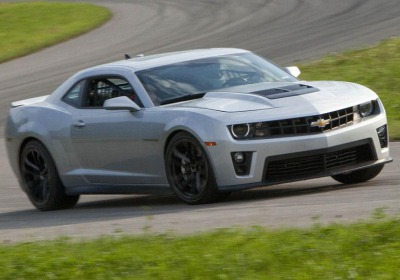Chevrolet reveals more details of Camaro ZL1
Fri, 09 Sep 2011
The 2012 Chevrolet Camaro ZL1 will not be anywhere near as rare as its 1969 namesake when it arrives during the first quarter of next year, but the most powerful production Camaro to date should deliver performance easily worthy of its model designation.
Camaro engineers on Thursday offered media members a preview of the upcoming Ford Mustang Shelby GT500 fighter, and the tale of the tape is impressive, especially in terms of grunt. The 6.2-liter supercharged LSA V8 will make 580 hp at 6,000 rpm and 556 lb-ft of torque at 4,200 rpm, besting Chevy's original targets for the engine's output and bettering its efficiency in the Cadillac CTS-V by 24 hp and 5 lb-ft.
For those keeping score against the GT500, the ZL1 trumps the top-of-the-range Mustang's ratings by 30 hp and 46 lb-ft.
As the Camaro team explained, the engine's improved numbers come thanks to “a unique induction system, with a lower-restriction air filter, dual ‘bell mouth' inlet paths, and improved airflow through the supercharger housing. Other changes include a higher-efficiency supercharger intercooler and electric power steering system, which consumes less engine power than hydraulic steering systems.”
However, Camaro chief engineer Al Oppenheiser and his colleagues made it clear that they intend the ZL1 to be far more than a drag racer right out of the box.
“[This car] is [road course-ready] from the showroom,” Oppenheiser said, pointing to the list of standard equipment to make his point: a liquid-to-liquid oil cooler lifted straight from the Corvette ZR1, a deep-sump oil pan, rear-differential cooler and--according the Oppenheiser--a fuel system with additional pickups that should feed the engine during hard cornering even when the gas tank is low on juice.
The ZL1 also comes with the third-generation of magnetic ride control, which reacts faster than before and now adjusts the suspension up to 1,000 times per second. Chevy said the new MRC “uses new twin-wire/dual-coil dampers at all four corners. The smaller dual-coil system--with one coil at either end of the damper--replaces the larger single-core design of the previous generation.
“The new design allows even more precise control of the electrical current and magnetic flux, allowing greater range than before between the softest setting for ride comfort and the firmest setting for track driving.”
If it works as claimed, the ZL1 has strong potential to join the growing rank of performance cars that provide extreme dynamics with little compromise to livability.
Meanwhile, the latest version of General Motors' Performance Traction Management is also present, with a Ferrari-like range of five settings spanning conditions from “wet” to “race.”
While the list of hardware is enticing, the ZL1's weight could be an Achilles heel in the eyes of road-course drivers: The power-to-weight ratio of 7.24 pounds per horsepower is, for example, better than a BMW M3 coupe's 8.9, but not as good as the GT500's 6.94 pounds. At about 4,200 pounds, the Camaro is a long, long way from a lightweight and will outweigh the GT500 by about 400 pounds.
From a driver-interface standpoint, the engineering crew's decision to adopt electronic power steering might appear an odd choice for an overpowering, rear-drive performance car, but Team Camaro insisted that the belt-driven, variable-ratio system is instead the best solution for controlling such an extreme automobile at speed while also making it comfortable for drivers at relatively low velocities in “real world” scenarios. “Hydraulic steering wasn't going to get it done,” Oppenheiser said.
Likewise, he stressed that the optional six-speed Hydra-Matic 6L90 automatic gearbox is “not for poseurs who don't know how to shift.” As a general rule, hard-core enthusiasts will choose the six-speed Tremec manual transmission, but at least the auto 'box is built for performance, with three different driving modes including a manual setting that only shifts when a driver commands. Automatic upshifts will not occur even at redline, and Oppenheiser promised that it will select and hold the appropriate low gear into corners to match the manual-equipped ZL1's performance.
“Contrary to what we could have done [by taking the easy way out with a simple, off-the-shelf transmission], the automatic is not a compromise,” he said. “We spent a lot of time working on it for the track.”
Other ZL1 items of note include Brembo brakes (six-piston front, four-piston rear), an active exhaust system like the one featured on the ZR1, and aerodynamic elements including a “belly pan” flat-bottom cover beneath the car. (Chevy was not ready to reveal final downforce numbers.)
Variable stiffness halfshafts and strengthened joints and suspension parts are intended to help reduce wheel hop under acceleration. As for rubber, Goodyear designed ZL1-specific Eagle F1 tires (285/35ZR-20 front, 305/35ZR-20 rear) to put the generous power to the road surface, be it straight, twisting or somewhere in between.
Chevy still will not confirm final details such as price (expected to fall in the low $50,000 range) or production numbers--figure on about 5,000 ZL1s built per year in General Motors' Oshawa, Ontario, Canada, assembly plant. But from what we've seen at this point, the Camaro ZL1 is armed with plenty to look forward to when our first drives occur in about two months--test drives are timed to coincide with dealerships opening their books for orders. The preliminary spec sheet, like the Corvette's, promises top-notch speed, ride and handling, and enough comfort for daily driving and road trips.
Speaking of which, we have reason to expect that fans who trek to Florida's Homestead-Miami Speedway for NASCAR's Sprint Cup Series season finale in November might very well find themselves on hand for the definitive ZL1 production car's official public debut.
By Mac Morrison



